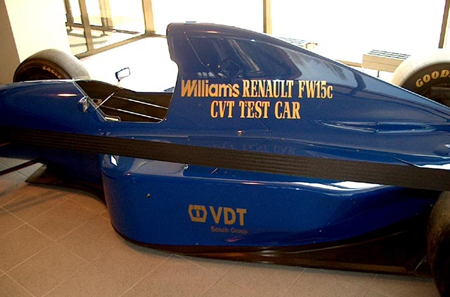Formula One CVT (Part 2)
 In the previous article, we looked at the prototype Formula One constantly variable transmission (CVT) system that Williams developed in conjunction with Van Doorn in the early 1990s, and spoke to engineer Arnaud Boulanger who was involved with the project.
In the previous article, we looked at the prototype Formula One constantly variable transmission (CVT) system that Williams developed in conjunction with Van Doorn in the early 1990s, and spoke to engineer Arnaud Boulanger who was involved with the project.
Anyone who follows Formula One closely will remember the dominant position that Williams had at that time. The CVT's development happened during a golden era for Williams; having the best car, they attracted the best drivers and for years were considered 'kingmakers' owing to the fact that, more often than not, the world champions drove a Williams.
The nature of the relationship between Williams and Van Doorn was one of exclusivity. Had the CVT not been banned, the route to development of a successful system for other teams would have been made harder by this deal.
The FIA introduced a rule mandating that Formula One transmissions should have "a minimum of 2 and a maximum of 7 discrete gear ratios", thus outlawing the CVT system. The fact that the car test had been a success escaped to the outside world; the rule was introduced suddenly and within two weeks of that first car test. But there were few protests from within the team when the rule was introduced.
So what would the implications have been for the hard-working engineers at Renault Sport's Viry-Chatillon base and the engineers at Williams, specific to the use of this transmission for racing? As mentioned in the previous article, they would have needed to re-optimise the engine for a single speed and undertake much durability work in order to make the engine survive such a high duty cycle. At the time, the maximum output was at a lower speed than that at which the Formula One engines run today, but it would have been a very big task.
Boulanger says, "In a race mode we would have had to design a new specific engine further optimised around peak power that could last 90 minutes at 15,000 rpm continuous." There was also the matter of the size and mass of the new transmission, of which Boulanger remarks, "Yes, it was quite heavy and big (in volume), which is something Patrick Head and Adrian Newey did not like!"

We can easily understand that heat rejection would be much higher, given the increased average engine output, so there would have been a marked increase in the size of the radiators, and there would also therefore have been an aerodynamic penalty to this extra cooling requirement. This would have had its own weight penalty with larger sidepods, larger radiators and more fluids being carried on the car.
We can see that, beyond the initial successful test where the concept was proven to work and to be very effective, there would have been a tremendous amount of work to do in order to make any car using such a system race-worthy. In fact, had the FIA not banned the system - and had Williams and Renault carried out the required work - their position of dominance would have been absolutely unassailable, and it could have changed Formula One for a long time.
Fig. 1 - The Williams CVT Formula One car. Will we ever see its like again?
Written by Wayne Ward